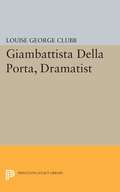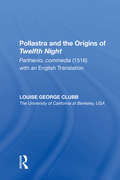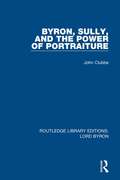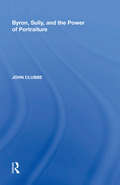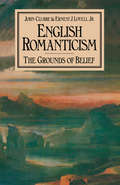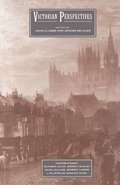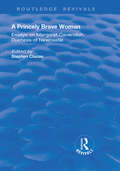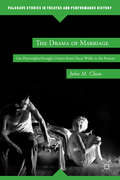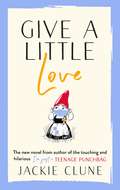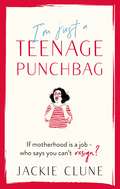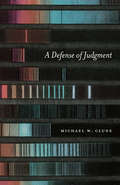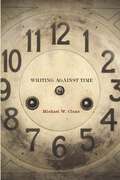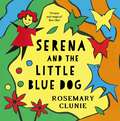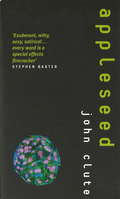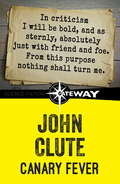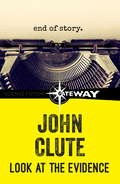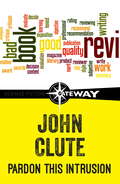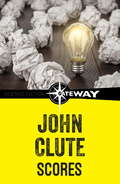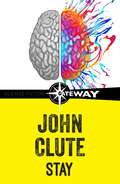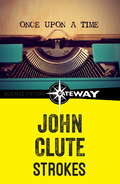- Table View
- List View
Giambattista Della Porta, Dramatist
by Louise George ClubbAlthough Renaissance scholars generally agree that Della Porta was the finest comic playwright of his generation in Italy, no detailed analysis of these plays and of their considerable influence outside Italy has previously appeared. One of the most famous men of his time in the field of scientific investigation, Della Porta wrote plays for relaxation and, on occasion, to camouflage controversial aspects of his scientific research from the Inquisitions. Today his works in science are largely forgotten and his right to fame rests on the plays. This book brings together the available facts of Della Porta's rich and often mysterious life and closely examines his dramatic works as part of the Italian literary scene in late Renaissance.Originally published in 1965.The Princeton Legacy Library uses the latest print-on-demand technology to again make available previously out-of-print books from the distinguished backlist of Princeton University Press. These editions preserve the original texts of these important books while presenting them in durable paperback and hardcover editions. The goal of the Princeton Legacy Library is to vastly increase access to the rich scholarly heritage found in the thousands of books published by Princeton University Press since its founding in 1905.
Pollastra and the Origins of Twelfth Night: Parthenio, commedia (1516) with an English Translation (Anglo-Italian Renaissance Studies)
by Louise George ClubbPollastra and the Origins of Twelfth Night addresses two closely linked and increasingly studied issues: the nature of the relation of Shakespeare's plays to Italian culture, and the technology of modern theater invented in Renaissance Italy. The discovery of forgotten works by Giovanni Lappoli, known as Pollastra, led to publication in Italy in 1993 in a limited edition of the Italian texts with supplemental scholarship by the authors, entitled Romance and Aretine Humanism in Sienese Comedy. One of those texts, the comedy Parthenio, has escaped the attention of theater bibliographers, because it was quickly sold out in its time and only a handful of copies are known to exist today. Yet it played an important part in the birth of Italian Renaissance drama and of modern comedy in general, in that it was the immediate predecessor and source of Gl'Ingannati, arguably the most famous comedy of the Italian Renaissance and certainly the most imitated, translated, adapted all over Europe. The best known of its progeny is Shakespeare's Twelfth Night. Much has been written in Italy and England about Gl'Ingannati and Shakespeare's debt to it, but nothing at all about Parthenio. This volume provides the first English translation (with the original Italian on facing pages); and presents for an international audience the theatrical scholarship from the 1993 book Romance and Aretine Humanism in Sienese Comedy, augmented with new findings.
Pollastra and the Origins of Twelfth Night: Parthenio, commedia (1516) with an English Translation (Anglo-Italian Renaissance Studies)
by Louise George ClubbPollastra and the Origins of Twelfth Night addresses two closely linked and increasingly studied issues: the nature of the relation of Shakespeare's plays to Italian culture, and the technology of modern theater invented in Renaissance Italy. The discovery of forgotten works by Giovanni Lappoli, known as Pollastra, led to publication in Italy in 1993 in a limited edition of the Italian texts with supplemental scholarship by the authors, entitled Romance and Aretine Humanism in Sienese Comedy. One of those texts, the comedy Parthenio, has escaped the attention of theater bibliographers, because it was quickly sold out in its time and only a handful of copies are known to exist today. Yet it played an important part in the birth of Italian Renaissance drama and of modern comedy in general, in that it was the immediate predecessor and source of Gl'Ingannati, arguably the most famous comedy of the Italian Renaissance and certainly the most imitated, translated, adapted all over Europe. The best known of its progeny is Shakespeare's Twelfth Night. Much has been written in Italy and England about Gl'Ingannati and Shakespeare's debt to it, but nothing at all about Parthenio. This volume provides the first English translation (with the original Italian on facing pages); and presents for an international audience the theatrical scholarship from the 1993 book Romance and Aretine Humanism in Sienese Comedy, augmented with new findings.
Byron, Sully, and the Power of Portraiture (Routledge Library Editions: Lord Byron)
by John ClubbeFirst published in 2005. Since the early nineteenth century, Byron, the man and his image, have captured the hearts and minds of untold legions of people of all political and social stripes in Britain, Europe, America, and around the world. This book focuses on the history and cultural significance for Federal America of the only portrait of Byron known to have been painted by a major artist. In private hands from 1826 until this day, Thomas Sulley’s Byron has never before been the subject of scholarly study. Beginning with the discovery of the portrait in 1999 and a 200-year narrative of the portrait’s provenance and its relation to other well-known Byron portraits, the author discusses the work within the broad context of British and American portraiture of the late eighteenth and early nineteenth centuries.
Byron, Sully, and the Power of Portraiture (Routledge Library Editions: Lord Byron)
by John ClubbeFirst published in 2005. Since the early nineteenth century, Byron, the man and his image, have captured the hearts and minds of untold legions of people of all political and social stripes in Britain, Europe, America, and around the world. This book focuses on the history and cultural significance for Federal America of the only portrait of Byron known to have been painted by a major artist. In private hands from 1826 until this day, Thomas Sulley’s Byron has never before been the subject of scholarly study. Beginning with the discovery of the portrait in 1999 and a 200-year narrative of the portrait’s provenance and its relation to other well-known Byron portraits, the author discusses the work within the broad context of British and American portraiture of the late eighteenth and early nineteenth centuries.
Byron, Sully, and the Power of Portraiture
by John ClubbeSince the early nineteenth century, Byron, the man and his image, have captured the hearts and minds of untold legions of people of all political and social stripes in Britain, Europe, America, and around the world. This book focuses on the history and cultural significance for Federal America of the only portrait of Byron known to have been painted by a major artist. In private hands from 1826 until this day, Thomas Sully's Byron has never before been the subject of scholarly study. Beginning with his discovery of the portrait in 1999 and a 200-year narrative of the portrait's provenance and its relation to other well-known Byron portraits, the author discusses the work within the broad context of British and American portraiture of the late eighteenth and early nineteenth centuries. Receiving most attention are Thomas Lawrence and Sully, his American counterpart. The author gives the fullest account to date of Sully's career and his relation to English influences and to figures prominent in the early-nineteenth-century American imagination, among them, Washington, Fanny Kemble, Lafayette, Joseph Bonaparte, and Nicholas Biddle. Byron is discussed as an icon of the young American Republic whose Jubilee year coincided with Sully's initial work on the poet's portrait. Later chapters offer a close reading of the portrait, arguing that Sully has given a visual interpretation truly worthy of his celebrated, controversial, and famously handsome subject.
Byron, Sully, and the Power of Portraiture
by John ClubbeSince the early nineteenth century, Byron, the man and his image, have captured the hearts and minds of untold legions of people of all political and social stripes in Britain, Europe, America, and around the world. This book focuses on the history and cultural significance for Federal America of the only portrait of Byron known to have been painted by a major artist. In private hands from 1826 until this day, Thomas Sully's Byron has never before been the subject of scholarly study. Beginning with his discovery of the portrait in 1999 and a 200-year narrative of the portrait's provenance and its relation to other well-known Byron portraits, the author discusses the work within the broad context of British and American portraiture of the late eighteenth and early nineteenth centuries. Receiving most attention are Thomas Lawrence and Sully, his American counterpart. The author gives the fullest account to date of Sully's career and his relation to English influences and to figures prominent in the early-nineteenth-century American imagination, among them, Washington, Fanny Kemble, Lafayette, Joseph Bonaparte, and Nicholas Biddle. Byron is discussed as an icon of the young American Republic whose Jubilee year coincided with Sully's initial work on the poet's portrait. Later chapters offer a close reading of the portrait, arguing that Sully has given a visual interpretation truly worthy of his celebrated, controversial, and famously handsome subject.
Victorian Perspectives: Six Essays
by John Clubbe Jerome MeckierThese essays focus on major figures, works or themes and movements of the Victorian era. They strive for fresh perspectives and aim to fill the gap in critical literature while reflecting the book's recurring concern with contexts and stratagems of presentation.
A Princely Brave Woman: Essays on Margaret Cavendish, Duchess of Newcastle
by Stephen ClucasThis title was first published in 2003. This collection of essays presents a variety of new approaches to the oeuvre of Margaret Cavendish, Duchess of Newcastle, one of the most influential and controversial women writers of the seventeenth century. Reflecting the full range of Cavendish's output - which included poetry, drama, prose fictions, orations, and natural philosophy - these essays re-assess Cavendish's place in seventeenth- century literature and philosophy. Whilst approaching Cavendish's work from a range of critical (and disciplinary) perspectives, the authors of these essays are united in their commitment to recovering her writings from their frequent characterisation as "eccentric" or "idiosyncratic", and aim to present her work as historically legible within the cultural contexts in which they were written. The "Mad Madge" of literary legend and tradition is re-written as a bold, innovative and experimental creator of a female authorial voice, and as a thinker vitally in contact with the intellectual currents of her age.
A Princely Brave Woman: Essays on Margaret Cavendish, Duchess of Newcastle
by Stephen ClucasThis title was first published in 2003. This collection of essays presents a variety of new approaches to the oeuvre of Margaret Cavendish, Duchess of Newcastle, one of the most influential and controversial women writers of the seventeenth century. Reflecting the full range of Cavendish's output - which included poetry, drama, prose fictions, orations, and natural philosophy - these essays re-assess Cavendish's place in seventeenth- century literature and philosophy. Whilst approaching Cavendish's work from a range of critical (and disciplinary) perspectives, the authors of these essays are united in their commitment to recovering her writings from their frequent characterisation as "eccentric" or "idiosyncratic", and aim to present her work as historically legible within the cultural contexts in which they were written. The "Mad Madge" of literary legend and tradition is re-written as a bold, innovative and experimental creator of a female authorial voice, and as a thinker vitally in contact with the intellectual currents of her age.
The Drama of Marriage: Gay Playwrights/Straight Unions from Oscar Wilde to the Present (Palgrave Studies in Theatre and Performance History)
by J. ClumIn studying performances of marriage in modern and contemporary British and American drama, Clum highlights the fact that - paradoxically - at a time when theatre was both popular entertainment and high culture, many of the most commercially and artistically successful plays about marriage were written by homosexual men. Beginning with Oscar Wilde and focusing on some of the most successful British and American playwrights of the past century, including Somerset Maugham, Noël Coward, Terence Rattigan, and Emlyn Williams in England and Clyde Fitch, George Kelly, Tennessee Williams, William Inge, and Edward Albee in the US, The Drama of Marriagelooks at how the plays they wrote about heterosexual marriage continue to impact contemporary gay playwrights and the depiction of marriage today.
Give a Little Love: The latest novel from the author of I'm Just a Teenage Punchbag
by Jackie Clune**FROM ONE OF THE STARS OF BBC'S HIT SERIES MOTHERLAND**London, March 2020. Angela is reeling from the sudden death of her husband Robert. As the world hunkers down against the pandemic, she and her two children - home from university - lock down in their grief and remembrance. Except Angela has this gnawing sensation, a tightness in her chest every time she thinks of Robert. He could be harsh, critical, often belittling in front of others. But he did his best - didn't he? He looked after them, even if he did make the decisions and laugh at her small ambitions. Even if he controlled most things in Angela's so-called life.As lockdown drags on with its do-gooder neighbours and their cake-baking and competitive Clapping for Carers, Angela makes a disturbing discovery on Robert's old phone: messages from a woman who clearly had a close relationship with her late husband. Enraged but liberated by the betrayal, Angela starts to reclaim her life.Until she runs into Zana. Zana, who appears to be watching her house. Zana, with her small child in tow. Zana, and her inexplicable connection to Robert...When Angela decides to help Zana she is forced to reframe her outlook, check her privilege and confront how exactly she plans to live the rest of her life. Slowly they build a relationship based on their mutual recognition, and when Zana introduces Angela to her friends at the local homeless mother and child hostel, she discovers a different, more hopeful, kind of family bubble.Wickedly dark but full of heart, this is a story of pulling together and finding love and connection in the most surprising of places.
I'm Just a Teenage Punchbag: THE BIG NEW COMIC NOVEL FOR A GENERATION
by Jackie Clune'A bloody marvellous read. Horribly familiar, funny, touching, sad, brutally honest ... I recommend you clutch this book to your stained T-shirt and never let it go.' JO BRAND'Obligatory reading for all parents of teenagers!' NIGELLA LAWSON'... terrific. A remarkable blend of hilarity and heartbreak with a really satisfying plot. Being childless never felt so good.' GRAHAM NORTON'Honest, hilarious and painful' WOMAN & HOMEWarning!! This novel may lead you to make rash and life-changing decisions!**Probably don't read if you fear you may be ripe for liberation. Or if you sometimes wee when you laugh...First there was Having It All, then there was Bridget Jones' s Diary and I Don't Know How She Does It. Now there is Teenage Punchbag.I'm Just A Teenage Punchbag is a laugh-out-loud, sob-on-the bus journey through the so-called life of a middle-aged woman.Ciara is mother to three ungrateful, entitled teenagers, is married to steady Martin, a man with hairy udders, and is grieving for her mum who now lives in the wardrobe in a cardboard box from the crematorium. She finds solace in her anonymous blog, and in the daily chats she has with her mum's ashes (often the best conversations she has all day.)Despite the menopause, the invisibility of middle age and the daily self-esteem bashings, courtesy of her kids, Ciara manages to navigate the stormy waters of grief and family life - until her mask slips and she is cast out from the family bosom. She embarks on a mission to fulfil her mum's dying wishes to have her remains sprinkled from the top of the Empire State Building, finding company, distraction and - ultimately - herself in the process.If motherhood is a job - who says you can't resign?
A Defense of Judgment
by Michael W. CluneTeachers of literature make judgments about value. They tell their students which works are powerful, beautiful, surprising, strange, or insightful—and thus, which are more worthy of time and attention than others. Yet the field of literary studies has largely disavowed judgments of artistic value on the grounds that they are inevitably rooted in prejudice or entangled in problems of social status. For several decades now, professors have called their work value-neutral, simply a means for students to gain cultural, political, or historical knowledge. Michael W. Clune’s provocative book challenges these objections to judgment and offers a positive account of literary studies as an institution of aesthetic education. It is impossible, Clune argues, to separate judgments about literary value from the practices of interpretation and analysis that constitute any viable model of literary expertise. Clune envisions a progressive politics freed from the strictures of dogmatic equality and enlivened by education in aesthetic judgment, transcending consumer culture and market preferences. Drawing on psychological and philosophical theories of knowledge and perception, Clune advocates for the cultivation of what John Keats called “negative capability,” the capacity to place existing criteria in doubt and to discover new concepts and new values in artworks. Moving from theory to practice, Clune takes up works by Keats, Emily Dickinson, Gwendolyn Brooks, Samuel Beckett, and Thomas Bernhard, showing how close reading—the profession’s traditional key skill—harnesses judgment to open new modes of perception.
A Defense of Judgment
by Michael W. CluneTeachers of literature make judgments about value. They tell their students which works are powerful, beautiful, surprising, strange, or insightful—and thus, which are more worthy of time and attention than others. Yet the field of literary studies has largely disavowed judgments of artistic value on the grounds that they are inevitably rooted in prejudice or entangled in problems of social status. For several decades now, professors have called their work value-neutral, simply a means for students to gain cultural, political, or historical knowledge. Michael W. Clune’s provocative book challenges these objections to judgment and offers a positive account of literary studies as an institution of aesthetic education. It is impossible, Clune argues, to separate judgments about literary value from the practices of interpretation and analysis that constitute any viable model of literary expertise. Clune envisions a progressive politics freed from the strictures of dogmatic equality and enlivened by education in aesthetic judgment, transcending consumer culture and market preferences. Drawing on psychological and philosophical theories of knowledge and perception, Clune advocates for the cultivation of what John Keats called “negative capability,” the capacity to place existing criteria in doubt and to discover new concepts and new values in artworks. Moving from theory to practice, Clune takes up works by Keats, Emily Dickinson, Gwendolyn Brooks, Samuel Beckett, and Thomas Bernhard, showing how close reading—the profession’s traditional key skill—harnesses judgment to open new modes of perception.
Writing Against Time
by Michael W. CluneFor centuries, a central goal of art has been to make us see the world with new eyes. Thinkers from Edmund Burke to Elaine Scarry have understood this effort as the attempt to create new forms. But as anyone who has ever worn out a song by repeated listening knows, artistic form is hardly immune to sensation-killing habit. Some of our most ambitious writers—Keats, Proust, Nabokov, Ashbery—have been obsessed by this problem. Attempting to create an image that never gets old, they experiment with virtual, ideal forms. Poems and novels become workshops, as fragments of the real world are scrutinized for insights and the shape of an ideal artwork is pieced together. These writers, voracious in their appetite for any knowledge that will further their goal, find help in unlikely places. The logic of totalitarian regimes, the phenomenology of music, the pathology of addiction, and global commodity exchange furnish them with tools and models for arresting neurobiological time. Reading central works of the past two centuries in light of their shared ambition, Clune produces a revisionary understanding of some of our most important literature.
Serena and the Little Blue Dog
by Rosemary ClunieA beautiful gift book and an original, modern fairy tale. Serena's adventure is full of charm and timeless magic, written in Rosemary Clunie's sparkling prose and illustrated in striking colour and collage.'Once upon a time a little girl called Serena lived in a cottage in the woods. She was friends with all the birds and animals of the forest. But what she really wanted was a special friend of her own.' When Serena meets the little blue dog, she names him Haiku and they become best of friends. But one day Haiku grows too big for Serena and her cottage in the woods. Together they travel to the edge of the forest, past fields of sunflowers and bright lakes to visit the green mountain bird, the red snake and the yellow fish. But it is the blue lady in a castle far away to the east who, by the magic of three stones, can help Serena find the answer.
Appleseed
by John CluteThe Klavier Station has been silently ambling through the empty sectors of the galaxy for longer than anyone can remember. If it hides a mystery, it is well concealed. Nathaniel Freer, a trader en route with a cargo of dedicated nano-robots, knows that he has been manoeuvred into stopping for repairs on Klavier having survived what was made to look like a botched attempt at piracy. And once there, he gradually begins to understand why. For his cargo is destined for a recently colonized planet whose only export promises to revolutionise data-processing. That export has a remarkable, ancient connection, with Klavier. And if it's reawakened, the universe will become a very different place.Fast-paced hard SF at its best, APPLESEED is a fireworks display of storytelling. More information on this book and others can be found on the Orbit website at www.orbitbooks.co.uk
Canary Fever
by John CluteCanary Fever is a collection of reviews about the most significant literatures of the twenty-first century: science fiction, fantasy and horror: the literatures Clute argues should be recognized as the central modes of fantastika in our times. The title refers to the canary in the coal mine, who whiffs gas and dies to save miners; reviewers of fantastika can find themselves in a similar position, though words can only hurt us.
Look at the Evidence: Essays And Reviews
by John CluteFor more than 50 years John Clute has been reviewing science fiction and fantasy. Look at the Evidence is a collection of reviews from a wide variety of sources - including Interzone, the New York Review of Science Fiction, and Science Fiction Weekly - about the most significant literatures of the twenty-first century: science fiction, fantasy and horror: the literatures Clute argues should be recognized as the central modes of fantastika in our times. It covers the period between 1987 and 1992.
Pardon This Intrusion: Fantastika In The World Storm
by John ClutePardon This Intrusion gathers together 47 pieces by John Clute, some written as long ago as 1985, though most are recent. The addresses and essays in Part One, "Fantastika in the World Storm", all written in the twenty-first century, reflect upon the dynamic relationship between fantastika - an umbrella term Clute uses to describe science fiction, horror and fantasy - and the world we live in now. Of these pieces, "Next", a contemporary response to 9/11, has not been revised; everything else in Part One has been reworked, sometimes extensively. Parts Two, Three and Four include essays and author studies and introductions to particular works; as they are mostly recent, Clute has felt free to rework them where necessary. The few early pieces - including "Lunch with AJ and the WOMBATS", a response to the Scientology scandal at the Brighton WorldCon in 1987 - are unchanged.
Scores: Reviews 1993-2003
by John CluteFor more than 50 years John Clute has been reviewing science fiction and fantasy. As Scores demonstrates, his devotion to the task of understanding the central literatures of our era has not slackened. There are jokes in Scores, and curses, and tirades, and apologies, and riffs; but every word of every review, in the end, is about how we understand the stories we tell about the world. Following on from his two previous books of collected reviews (Strokes and Look at the Evidence) this book collects reviews from a wide variety of sources, but mostly from Interzone, the New York Review of Science Fiction, and Science Fiction Weekly. Where it has seemed possible to do so without distorting contemporary responses to books, these reviews have been revised, sometimes extensively. 125 review articles, over 200 books reviewed in more than 214,000 words.
Stay
by John CluteStay gathers together 100,000 words of reviews, plus short fiction by John Clute, and was originally published to coincide with Loncon3 (the 2014 World Science Fiction Convention) at which he was one of the Guests of Honour.Also included is a complete reprint of the text of The Darkening Garden.
Strokes: Essays And Reviews, 1966-1986
by John CluteFor more than 50 years John Clute has been reviewing science fiction and fantasy. Strokes is a collection of reviews from a wide variety of sources - including Interzone, the New York Review of Science Fiction, and Science Fiction Weekly - about the most significant literatures of the twenty-first century: science fiction, fantasy and horror: the literatures Clute argues should be recognized as the central modes of fantastika in our times. It covers the period between 1966 and 1986.
